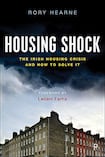
Housing was one of the defining issues of this year’s general election. Respondents to the RTÉ exit poll in February listed it as their second most important concern at 26 per cent.
While the health and economic impacts of Covid-19 have understandably overtaken all other issues, housing is still at the forefront of many people’s minds. The Irish Times IPSOS/MRBI poll in June listed housing as the most pressing non-Covid issue for voters, at 17 per cent statewide and 25 per cent in Dublin.
The reason for this is quite simple. Ever-greater numbers of people are unable to access secure and affordable homes. The housing crisis is no longer an issue for those on the margins of our society alone. Even people in stable jobs with decent incomes are finding it hard to rent or buy.
Housing Shock, by Maynooth University social policy lecturer Rory Hearne, seeks to understand the reasons for our ever-deepening housing crisis. The author brings two decades of academic, community and campaigning experience to bear on his account of the causes of the crisis and what we should do to fix it.
At the centre of Hearne’s critique of the Irish housing system is neo-liberalism. From the late 1980s through to the present, public policy treated housing as an asset class rather than a public good.
Covering credit liberalisation in the 1980s, loose mortgage lending in the 1990s and the Great Wall of Money unleashed into the property market after the economic collapse of 2008, Hearne argues that transforming housing into an investment makes it more expensive and less secure for millions of people.
Housing Shock also details the flip side of this ever-greater financialisation of housing, as government withdraws from the direct provision of public housing for working people. Ever-lower levels of investment in social housing resulted in increasing dependence on taxpayer-subsidised private rental accommodation, costing the State billions of euro without giving tenants real security.
The consequences of this double-sided policy are everywhere to be seen. Hearne describes the harsh reality for Generation Rent, trapped in an overpriced, insecure private rental sector. They earn too much to access social housing but not enough to buy their own home. Instead they are paying 40 per cent or more of their take-home pay to live in someone else’s property.
Things have become so intolerable in the rental market that a new group has emerged, Generation Stuck at Home. Hearne details the growing number of young people living at home with their parents, with 80 per cent of men and 75 per cent of women under the age of 29 still at home, compared with 40 per cent and 32 per cent in Denmark.
At its harshest edge our insecure and unaffordable housing system has resulted in the highest levels of homelessness in decades. Drawing on his research with Maynooth University colleague Dr Mary Murphy, Hearne takes us behind the statistics to discuss the human impact of long-term homelessness on adults and children. He reveals the physical, developmental and emotional scars that living in hostels and hubs has had on thousands of people in recent years.
Ireland’s shift from large-scale State intervention in housing from the 1930s to an over-reliance on the private sector from the late 1980s has been detailed expertly elsewhere, most notable in Drudy and Punch (2005) and Norris (2017). However, Hearne updates the story with significant detail on the post-2008 developments.
The interaction of Fine Gael’s tax breaks for international equity investment, fuelled by US and EU quantitative easing and attracted to the distressed assets held by Nama, is the latest chapter in the sorry tale of housing financialisation. The growing role played by Real Estate Investment Trusts, particularly in the apartment market in Dublin, is fuelling a further round of speculative investment, pushing prices ever upwards.
Hearne also provides a detailed account of the popular reaction to the housing crisis in a chapter titled The People Push Back. He details the growing local and State-wide housing campaigns and mobilisations from 2014 to the present. More than 26 different initiatives, from Housing Action Now to Apollo House to Raise the Roof, all contributed to the growing momentum for change in housing policy that ran through this year’s general election.
With an eye to the new Government and its programme commitment to deliver Housing For All, Hearne concludes Housing Shock with his own prescriptions for solving our housing crisis. At the centre of his proposals are recognising housing as a human right and a major investment in public housing on public land to realise that right.
Hearne, drawing on research from Ireland and abroad, makes a compelling case for enshrining the right to housing in our Constitution. He also maps out the scale of public investment needed to meet the needs of those in or at risk of homelessness and waiting for social or affordable housing.
In arguing for a Green New Deal for Housing, Hearne makes the case for “a counter power of civil society and public to force the state and government to change direction”. He urges the formation of an “alliance of renters, students, precarious workers and professionals, the middle class, aspirant home owners and those needing social housing”. Despite their superficial differences, he argues that they share a common goal of “affordable sustainable homes”.
Housing Shock is a valuable book. It is a tool for better understanding our current predicament and what we can do about it. But like all tools it is only of any value if we pick it up and use it to refashion the world around us. So buy, read and share Hearne’s Housing Shock. Let it empower you and motivate you to play a part in the growing campaign for secure, affordable and sustainable housing for all.
[ Home: Why Public Housing Is the AnswerOpens in new window ]









